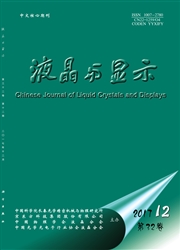

 中文摘要:
中文摘要:
合成了3种丙烯酸酯封端的取代苯甲酸以及其分别与4,4′-联吡啶和反式吡啶基乙烯自组装形成的双氢键液晶,采用傅立叶红外光谱(FTIR)和核磁共振法(1H-NMR)表征化合物的结构,使用偏光显微镜(POM)以及差示扫描量热仪(DSC)研究氢键液晶复合体的相转变行为。结果表明,在刚性液晶基元中引入氟原子会增加氢键液晶分子的宽度和降低分子的长径比对液晶材料的性能有很大影响,如降低氢键液晶的熔点以及清亮点等。另外,在柔性链末端引入丙烯酰氧基以及增加液晶基元的长度则会增加液晶分子的长度和规整性,提高氢键液晶复合体的相转变温度。
 英文摘要:
英文摘要:
Three kinds of acryloxy-capping substituted benzoic acid compounds were synthesized and characterized the corresponding symmetric hydrogen-bonded liquid crystals (H-boned LCs) based on 4, 4r- bipyridine (BP) or 4-((E)-2-(pyridin-4-yl)vinyl)pyridine (DPE) were prepared. The structure of pre- cursors as well as the H-bond structures were confirmed by the 1H nuclear magnetic resonance (1H- NMR) and by Fourier transform infrared spectroscopy (FTIR). The mesogenic behavior of the H- bonded complexes was demonstrated by the polarizing optical microscopy (POM) and the differential scanning calorimetry (DSC). It was found that the fluoro substituent on the mesogenic core made the molecular width increased and thus the aspect ratio of the molecular decreased, therefore it could weaken the mesogenic behaviors of the H-bonded LCs such as decreasing the melting point as well as the clear point. Additionally, the introduction of terminal acryloxy group and the increase of induced rigid core could enhance the molecular length and regularity, resulting in the increase of phase transition temperatures of the complexes.
 同期刊论文项目
同期刊论文项目
 同项目期刊论文
同项目期刊论文
 Influence of terminal alkyl chain length on helical twisting property of chiral 1,2-propanediol deri
Influence of terminal alkyl chain length on helical twisting property of chiral 1,2-propanediol deri Formation of surface relief gratings with homeotropically oriented photopolymer from a photocross-li
Formation of surface relief gratings with homeotropically oriented photopolymer from a photocross-li Electro-optical study of chiral nematic liquid crystal/chiral ionic liquid composites with electrica
Electro-optical study of chiral nematic liquid crystal/chiral ionic liquid composites with electrica Study on selective reflection properties of chiral nematic liquid crystalline composites with a non-
Study on selective reflection properties of chiral nematic liquid crystalline composites with a non- Broadband reflection in polymer stabilized cholesteric liquid crystal cells with chiral monomers der
Broadband reflection in polymer stabilized cholesteric liquid crystal cells with chiral monomers der Reflectance properties of polymer-stabilised cholesteric liquid crystals cells with cholesteryl comp
Reflectance properties of polymer-stabilised cholesteric liquid crystals cells with cholesteryl comp Effect of specific rotation of chiral dopant and polymerization temperature on reflectance propertie
Effect of specific rotation of chiral dopant and polymerization temperature on reflectance propertie Facile synthesis and characterization of novel thermo-chromism cholesteryl-containing hydrogen-bonde
Facile synthesis and characterization of novel thermo-chromism cholesteryl-containing hydrogen-bonde Characteristics of wide-band reflection of polymer-stabilised cholesteric liquid crystal cell prepar
Characteristics of wide-band reflection of polymer-stabilised cholesteric liquid crystal cell prepar Synthesis and characterization of non-symmetrical liquid crystals containing a cholesteryl ester moi
Synthesis and characterization of non-symmetrical liquid crystals containing a cholesteryl ester moi Homeotropic alignment of nematic liquid crystals by a photocross-linkable organic monomer containing
Homeotropic alignment of nematic liquid crystals by a photocross-linkable organic monomer containing Thermally controllable reflective characteristics from rupture and self-assembly of hydrogen bonds i
Thermally controllable reflective characteristics from rupture and self-assembly of hydrogen bonds i Wide blue phase range in a hydrogen-bonded self-assembled complex of chiral fluoro-substituted benzo
Wide blue phase range in a hydrogen-bonded self-assembled complex of chiral fluoro-substituted benzo Preparation and reflectance properties of new cholesteric liquid crystalline copolymers containing c
Preparation and reflectance properties of new cholesteric liquid crystalline copolymers containing c 期刊信息
期刊信息
